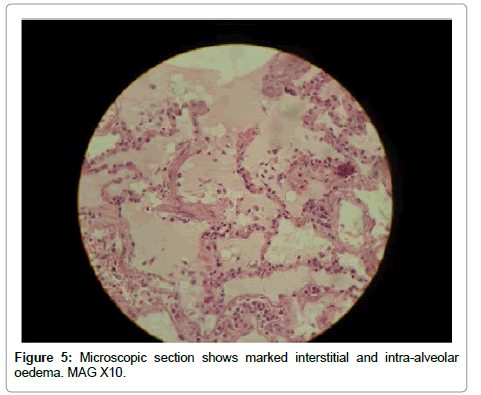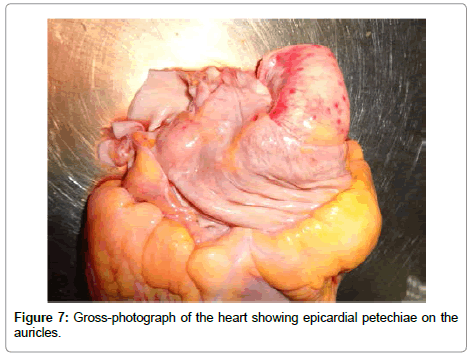Death of an Unknown Black Male Adolescent Stowaway in the Wheel-well Compartment of a Lagos Bound Plane: A Case Report
Received: 28-Aug-2013 / Accepted Date: 23-Nov-2013 / Published Date: 25-Nov-2013 DOI: 10.4172/2161-0681.1000150
Abstract
The body of a young black male suspected of stowing away in the wheel-well of a Lagos bound plane was found dead after it returned to Lagos from a flight to New York, United states. The body was reportedly discovered during a check on the aircraft panel as it was being prepared for another flight. There was no any means of identification on the body. External examination revealed a body of an adolescent age group. There were no signs of trauma or violence on the body although petechial haemorrhages were noted on the conjunctiva. Striking wrinkling of the extremities reminiscent of Washer man’s sign was however, observed. Internal examinations revealed essentially, marked fluidity of blood, petechiae on the interlobar surfaces of the lungs and epicardium. The left and right lungs weigh 550 and 600 gm respectively and showed congestion and oedema. The brain weighs 1600 gm, oedematous, as shown by narrowing of the sulci and flattening of the gyri. Toxicological studies could not be done due to lack of facilities. Cause of death was ascribed to asphyxia from a confined space (unpressurised and unheated) in (wheel-well) tyre compartment of a plane. Conclusion: Porous security at the airports needs to be improved upon and access to airside must be stringently prohibited especially now when there is increasing wave of terrorist attacks. Punitive measures must be meted out to airline operators and handling companies since it is a form of security laxity. If possible, the front and rear wheel compartments should be checked before any flight. It is likely such occurrence will continue. Mass media campaign amongst youths emphasizing the fact that wheel-wells stowaways are not safe should also be commenced.
Keywords: Hypoxia, Wheel-well, Stowaway, Oedema
309386Introduction
It is known that many desperate people have taken risky journeys as stowaways in aircraft wheel wells despite the risk of being crushed by retracting landing gear or experiencing severe hypoxia and hypobaria in flight [1]. The usual stowaways are males and no case of female stowaway has been reported. We report a case of a male black stowaway whose body was found lifeless in the wheel-well compartment of a Lagos bound plane.
Case Reports
The body of a young black male suspected of stowing away in the wheel-well of a Lagos bound plane was found dead after it returned from a flight to New York, United states. The body was reportedly discovered during a check on the aircraft panel as it was being prepared for another flight.
Pilots and aeronautical engineers who are familiar with the wheelwell compartment believe that the airbus A340-500 is roomy enough to accommodate a person, besides the space for the tyres.
The impression of the airline officials and police authorities whose attentions were drawn was that the deceased was probably crushed to death by the tyres.
There was no means of identification on the body. The deceased had on a light-blue muffler round the neck, two navy-blue inner undershirts and a green V-neck winter cheater jacket. The body was also dressed in multicolored boxers short, a pair of brown trousers, a pair of thick ankle length socks and a pair of orange sport foot wear. The mode of dressing suggested that the deceased was prepared for the extremely cold wheel-well compartment. Prior to the post-mortem examination, total body radiographic examination was done in addition to dental chatting which would likely help in the identification process since the deceased was still unidentifiable.
External examination revealed a body of an adolescent with height of 1.78 m and weight of 68.5 kg. There was no evidence of any natural disease. There were also no signs of trauma or violence on the body although petechial haemorrhages were noted on the conjunctiva. However, striking wrinkling of the extremities reminiscent of Washer man’s sign was observed.
Internal examinations revealed essentially marked fluidity of blood, petechiae haemorrhages on the interlobar surfaces of the lungs and epicardium. The left and right lungs weigh 550 and 600 gm respectively and showed congestion and oedema. Black anthracotic pigments were observed on the lungs surfaces.
The cardiovascular system was essentially unremarkable apart from the epicardial petechiae earlier described. The genitourinary system was also unremarkable apart from capsular surface which showed retention of fetal lobulation. The stomach was empty and the entire digestive system was unremarkable.
The brain weighs 1600 gm, oedematous as shown by narrowing of the sulci and flattening of the gyri.
Ancillary studies such as toxicology could not be done due to lack of facilities. For the purpose of identification, 5.0 cm of a segment of the Femur bone and a chunk of Iliopsoas muscle were taken and kept for DNA analysis while routine samples were taken for histology. Microscopic examination of the lungs showed marked congestion, intra-alveolar and interstitial oedema while the brain further revealed congested cerebral vascular channels and peri-nuclear halo compatible with cerebral oedema.
Cause of death was ascribed to asphyxia from a confined space (unpressurised and unheated) in (wheel-well) tyre compartment of a plane.
Discussion
The lowest part of the atmosphere that encircles the entire surface of the earth is known as the troposphere [2]. The barometric pressure within the troposphere falls as altitude (vertical height above sea level) increases. This results in reduced partial pressure of oxygen. This condition is known as hypobaric hypoxia [2]. In this case report, death was caused by asphyxia in a confined (unpressurised and unheated) space.
The wheel-well compartment of the plane is not pressurized and as such the deceased was exposed to hypobaric atmosphere especially at altitude of above 8,000meters above sea level. This has been known to be rapidly fatal [3].
The deceased had marked pulmonary and cerebral oedema consistent with the High Altitude Pulmonary Oedema (HAPE) and High Altitude Cerebral Oedema (HACE). These had also been previously documented [1]. A recent MRI study in persons with HACE suggested a predominantly vasogenic mechanism of cerebral oedema. Once vasogenic oedema develops cytotoxic oedema generally follows, and although likely in HACE, this is still unproven [4,5]. However, the severity and incidence of these two features are height and speed of ascent dependent suggesting a dose-response type of relationship [1,4].
It has been further established that HAPE occurs following a non uniform hypoxic pulmonary vasoconstriction creating a stress failure of pulmonary capillaries and a further increased permeability-type of oedema with background of normal left atrial pressure [6]. Early study has also shown that the early HAPE does not demonstrate inflammatory activation [7], however, studies done in Japan by Kubo 1996 et al., [8] and Kubo 1998 et al., [9] observed that well established HAPE has high levels of inflammatory cells and mediators (Figures 1-7).
Atmospheric pressure and inspired oxygen pressure fall linearly with increase in altitude, since the compartment is not pressurized and not heated, the fall in inspired oxygen pressure reduces the driving pressure for the exchange of gas in the pulmonary system which in effect results in a cascade of effects leading to cellular hypoxia [10].
Conclusion
Death was caused by asphyxia from a confined space (unpressurised and unheated) in (wheel-well) tyre compartment of a plane. Mass media campaign to youths emphasizing that wheel wells are not safe should also be commenced. Stowing is an indication of porous security at the airports, this should be improved upon and access to airside must be stringently prohibited especially now when there are increasing terrorist attacks. Terrorists might take advantage of this laxity in security. It is likely that such occurrence will continue in the nearest future. In addition, punitive measures must be meted out to airline operators and handling companies since it is a form of security laxity. If possible, the compartments should be checked before any flight.
Acknowledgements
We thank the Police authorities who provided the photographs; the morticians who assisted during the post mortem examination and the histotechnologist who prepared the slides and assisted during the grossing. We are grateful to the department for given us the approval to report this case.
References
- Perry G (2002) Wheel-well and cargo compartment temperatures of large aircraft in flight: implications for stowaways. Aviat Space Environ Med 73: 673-676.
- Grocott M, Montgomery H, Vercueil A (2007) High-altitude physiology and pathophysiology: implications and relevance for intensive care medicine. Crit Care 11: 203.
- Ward MP, Milledge JS, West JB (2000) High altitude Medicine and Physiology. (3rdedn), Br J Sports Med, London, Arnold.
- Hackett PH (1999) High altitude cerebral edema and acute mountain sickness. A pathophysiology update. Adv Exp Med Biol 474: 23-45.
- Hackett PH, Roach RC (2001) High-altitude illness. N Engl J Med 345: 107-114.
- Bärtsch P, Mairbäurl H, Maggiorini M, Swenson ER (2005) Physiological aspects of high-altitude pulmonary edema. J Appl Physiol (1985) 98: 1101-1110.
- Swenson ER, Maggiorini M, Mongovin S, Gibbs JS, Greve I, et al. (2002) Pathogenesis of high-altitude pulmonary edema: inflammation is not an etiologic factor. JAMA 287: 2228-2235.
- Kubo K, Hanaoka M, Yamaguchi S, Hayano T, Hayasaka M, et al. (1996) Cytokines in bronchoalveolar lavage fluid in patients with high altitude pulmonary oedema at moderate altitude in Japan. Thorax 51: 739-742.
- Kubo K, Hanaoka M, Hayano T, Miyahara T, Hachiya T, et al. (1998) Inflammatory cytokines in BAL fluid and pulmonary hemodynamics in high-altitude pulmonary edema. Respir Physiol 111: 301-310.
- Peacock AJ (1998) ABC of oxygen: oxygen at high altitude. BMJ 317: 1063-1066.
Citation: Soyemi SS, Oyewole OO, Faduyile FA, Okeke UV, Obafunwa JO (2013) Death of an Unknown Black Male Adolescent Stowaway in the Wheel-well Compartment of a Lagos Bound Plane: A Case Report. J Clin Exp Pathol 4:150. DOI: 10.4172/2161-0681.1000150
Copyright: © 2013 Soyemi SS, et al. pThis is an open-access article distributed under the terms of the Creative Commons Attribution License, which permits unrestricted use, distribution, and reproduction in any medium, provided the original author and source are credited.
Select your language of interest to view the total content in your interested language
Share This Article
Recommended Journals
Open Access Journals
Article Tools
Article Usage
- Total views: 18721
- [From(publication date): 1-2014 - Nov 21, 2025]
- Breakdown by view type
- HTML page views: 13895
- PDF downloads: 4826







